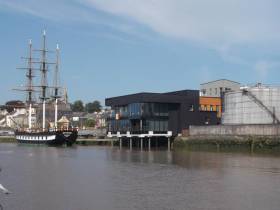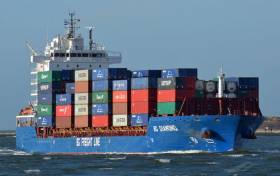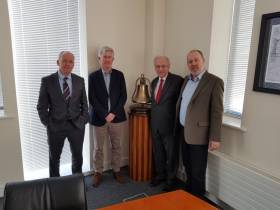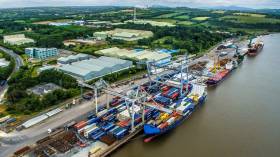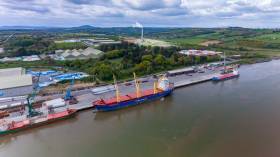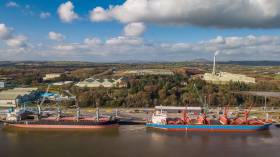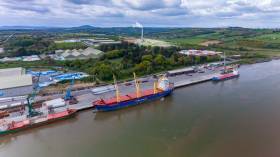Displaying items by tag: Port of Waterford
Wexford Council to Abandon New Ross Port to Waterford
At the historic Port of New Ross shipping will soon be run by Belview Port in Waterford, in a controversial move planned by Wexford County Council.
As the New Ross Standard reports, the Director of Services for Economic Development Tony Larkin made the announcement at the first meeting of the new Wexford County Council term on Friday.
In an update to councillors ahead of the imminent transfer of the port from the state to Wexford County Council, Mr Larkin said: 'We are taking over the operation of the port. We have been in due diligence for two years.'
Mr Larkin said he was informed last week that the takeover process has been completed, save for three ministers signing the document which will formally allow the transfer.
'The process of having the ministers sign it has now commenced. Immediately upon transfer all assets and staff will transfer to us and we will have responsibility as the port authority. We are not in the shipping business. We are in discussions with the Port of Waterford at Belview about them acting as our agents managing the shipping for a fee.'
To read further comments from Mr Larkin and more click here.
Shipping Company to Offer New Route from Port of Waterford
A shipping line based in the Netherlands, reports The Irish Times, will open up Waterford port to new international trade routes when it commences a weekly service on the Waterford to Rotterdam route which will act as a deep-sea feeder for Irish importers and exporters.
The Dutch operator BG Freight Line, in partnership with global shipping giant Maersk, is to commence the service on July 6th to support industry in the southeast. Effectively the move will allow goods travelling from Waterford to continue through Rotterdam to other ports such as Shanghai, whereas previously goods for destinations beyond Europe would typically have shipped from Dublin.
Part of the Peel Ports Group, BG Freight Line runs a fleet of 23 containerised vessels from its headquarters in the Netherlands. Maersk, meanwhile, is the largest container logistics organisation in the world, moving more than 12 million containers a year.
BG Freight Line chief executive Koert Luitwieler said the addition of Waterford to its network would strengthen the company’s Irish Sea network which encompassed routes from Dublin and Cork at present.
For more on this new additional Ireland-mainland Europe lo-lo service click here
On the southern tip of County Kilkenny is located the Port of Waterford which is beginning a public consultation process seeking inputs from all stakeholders on a proposed master plan setting out how the port could develop over the 25-year period to 2044.
As the Kilkenny People writes, the port company's draft masterplan outlines various demand scenarios that will determine capacity requirements at the port. The intention is that the masterplan will provide a framework for development and position the port to respond to emerging trends and opportunities.
The first consultation sessions will be held on the 4th floor of the Marine Point office development in Belview, County Kilkenny at 11:00 and 14:30 on Wednesday, 26 June.
A further session will be held in the Passage East/Cheekpoint area of County Waterford on 18 July with the time and venue to be posted on the port’s website once confirmed.
Click here for more on the master plan.
#irishports - Details of the Port of Waterford's financial results and operating performance for 2018 have been announced by the south-east port.
The company’s accounts reports Waterford Live, show operating profits of €1.9m for the year to December 31, an increase of 12% on 2017.
Turnover in 2018 was €8m, up from €7.6m in the prior year. Shareholders funds stood at €32.7m at the year-end and the company is to pay a dividend of €330,000 to the Department of Transport, Tourism and Sport.
Bulk throughput at the port in Belview, Co Kilkenny over the year amounted to 1.7m tonnes, a 28% increase on 2017 which had itself seen a 27% increase over 2016. Containers handled grew by 3% while there was strong breakbulk activity including, for example, shipments of steel and timber. This traffic reflects increased economic activity, including in the construction sector.
For more on the annual results click here.
Appointment of New Directors to Port of Waterford
#irishports - Minister for Transport, Tourism & Sport, Shane Ross, has appointed two new directors to the board of the Port of Waterford Company following a competitive process managed by the Public Appointments Service.
Waterford Live writes, William Johnston and Derry O’Sullivan will join the existing board members Joe Dreelan; Louise Grubb; John Kehoe; Mary Mosse; Frank Ronan, CEO and Des Whelan, chairman.
Mr Johnston recently retired as a partner with Arthur Cox Solicitors where he specialised in banking law, capital markets and regulation. A board member at the National Maternity Hospital and the Housing Finance Agency, he is a former chair of the Law Society’s Business Law Committee and former co-chair of the Banking Law Division at the International Bar Association.
To read more on the appointments, click here.
Port of Waterford Study Shows Zone Provides Almost 1,000 Jobs & Turnover Approaching €1bn
#Ports&Shipping - The Port of Waterford have commissioned an economic impact study that shows the Belview Industrial Zone surrounding and including the port (see snapshot) supports 632 full-time jobs directly and a further 348 indirectly, a total of 980.
Last year the 265-hectare zone in south Co Kilkenny generated a turnover of €388m directly and a further €555m through its multiplier effect in the wider economy. Overall this gave an impact of €942.4m.
The Port of Waterford added that the zone’s estimated gross valued added (GVA) last year was more than €190m while the direct regional impact of the Belview Industrial Zone is underlined by a review of those employed within it.
Of 588 personnel reviewed for the study, 317 (54%) live in Waterford, 147 (25%) in Kilkenny and 94 (16%) in Wexford. This makes the Belview Industrial Zone one of the biggest sources of employment across three counties in the southeast with the remainder commuting from counties Tipperary, Laois, Limerick, Kildare and Cork.
The value of goods shipped through the Port annually is estimated at €1.7bn in the 36-page study completed by Raymond Burke Consulting.
Reviewing the sources and destinations for freight transiting Waterford, the report’s authors found the direct impacts of Brexit should be minimal as three-quarters of the Port’s business is with mainland Europe and just 2% with the U.K. Furthermore the Port’s south-east location makes it a good option to facilitate businesses wishing to bypass the UK and provide direct connections with the continent.
Boost for Port of Waterford As Planning Permission Granted for Bulk Stores
#IrishPorts- Shipping agency, Suir Shipping Ltd has been granted planning permission for Bulk Stores measuring 8,030 sq m at Waterford Port, located in Belview, south Kilkenny.
The stores writes The Kilkenny People will be used to store port related products such as bulk break, bulk and unitised products.
The site works will include two weighbridges, weighbridge office, entrance gates and fencing, concrete paving, water services including a borewell and a water storage tank, drainage and waste water treatment at Gorteens, Slieverue.
Port of Waterford Announces Improved 2017 Results
#Ports&Shipping - The Port of Waterford announced details today of its trading results for 2017 and reported operating profits for the financial year of €1.7m
The figure is a significant improvement on the operating performance when compared to €250,000 recorded in 2016.
Turnover was €7.6m (vs €6.3m in the previous year) and shareholder’s funds ended the year at €30.5m.
Bulk throughput came in at just over 1.3m tonnes, a 27% increase on 2016. Containers handled grew by 3% with strong results from project cargo and break bulk activity.
Frank Ronan, Chief Executive, Port of Waterford Co commented: “This has been an excellent trading year for Port of Waterford. Buoyancy in agri markets has driven strong demand for fertiliser and feedstuffs. These factors together with good construction demand and project cargo activity around renewable energy infrastructure has kept us very busy in Belview during 2017.”
2018 indicators
Mr Ronan noted: “Activity during the first quarter of this year is pretty much in line with last year. We anticipate that some lines may not perform quite as strongly in 2018 as they did in 2017 due to market conditions. Having said that, we see some very significant and timely investments going ahead in the Port zone this year that will underpin and drive growth in 2019 and beyond.
On the container handling side, we have not attracted any new services that would provide deep sea connections into the Port. However, we are seeing ongoing growth in our traditional short sea routes serving European markets. Brexit may well provide further opportunities for these load-on/load-off container services that bypass the UK land bridge and provide a very efficient solution for cargo into and out of Europe.”
Masterplan
Capt Darren Doyle, Harbourmaster, confirmed that the estuarial model developed during 2017 is now fully functional and available to support the master planning process that is now underway. He noted that: “This process will evaluate demand, environmental issues, facilities and any required development in a systematic and transparent way. We look forward to ongoing consultation and engagement with our wide range of stakeholders over the next nine months on this issue.”
Ports of Waterford and Rosslare Can “Counterbalance” Dublin
#CounterPorts - It is the belief of management at the Ports of Waterford and Rosslare Europort that they can become ‘valuable counterpoints’ to reduce congestion in the Dublin area while also supporting a ‘robust and pragmatic’ response to Brexit.
The ports have made a joint submission writesThe Munster Express to the South East Chambers of Commerce’s final submission to the National Planning Framework (NPF – ‘Ireland 2040 – Our Plan’) which is set to guide planning over the next 20 years.
“The south east ports together provide a full range of services to the South-East region and beyond. Rosslare Europort and Waterford (Belview) are Tier 2 Ports of National Significance and are Comprehensive Ports on the Ten-T network,” they state in their submission. “The ports have Ro-Ro, Lo-Lo, bulk and passenger services/facilities with excellent road/rail connectivity and direct links to the UK and the continent. These ports have some areas of under-utilised capacity and significant scope for the expansion of freight services.”
The report adds: “In the context of some of the challenges posed by Brexit, the South East can offer a platform for solutions that bypass the UK land bridge with little or no upfront investment.
N19S1Pic1
“Similarly, the opportunity is there to reduce freight road miles and related CO2 emissions while taking some pressure off of Dublin’s road and port infrastructure. We submit that the south east ports have a very significant role to play in the economic development of the south east and that this role is equivalent to that performed by the Tier 1 Ports (Dublin, Cork and Shannon Foynes) for their respective regions.”
To read more on this story, click the link here.
#Railfreight - It was another year of increases to rail freight traffic on Iarnród Éireann / Irish Rail (IÉ) during 2016 according to MultiModal, with the number of freight trains operated being up 6% and tonnes carried up by 8% on 2015.
In 2015, 96.4 million tonne kilometres of freight were moved by rail in Ireland and this increased by 5% to 101.5 million tonne kilometres in 2016. In that same year multimodal trains serving DFDS Logistics (shipping container operator) increased by 6%. The railway operation is run by Dublin based International Warehousing and Transport (IWT).
IWT commenced their rail operation on 19 August 2008 with just two return trains per week from Dublin Port to Ballina in County Mayo and now with up to seven return trains per week the 2000th train was operated for the company by IÉ on 16th August this year. Two return multimodal services per week are also operated for DFDS Logistics between Port of Waterford (see 2016 overall figures) and Ballina, with shipping connections to Europe via Rotterdam.
Multimodal traffic has been steadily increasing on IÉ now for several years with soft drinks and medical supplies for export being amongst the staple loadings. Rail routes from Dublin and Waterford ports are both cleared for conveying 9’6’’ hi-cube containers on standard platform wagons.
The number of bulk trains carrying pulpwood and zinc ore were also up by 6% on 2015. Pulpwood trains are operated for Coillte from Waterford and Ballina to Waterford where the timber is used for the manufacture of building products, most of which are exported. The ore trains operate twice daily from Navan to Dublin Port from where the product is exported.
During 2016 IÉ successfully completed the trail run of a 54 TEU multimodal freight train, the longest ever freight train run in Ireland.
Other initiatives during the year include ‘Rapid Rail’, a rail parcels service and also parcels collection lockers at principal stations on the network. The IÉ freight sector also operate ‘Navigator’, which specialises in the collection and distribution of automotive car parts. Navigator is amongst the best service of its kind in Europe with 99.6% of all deliveries arriving on time throughout the island of Ireland.


























